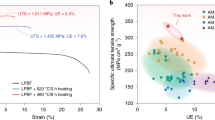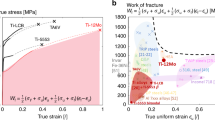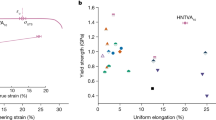Abstract
TiAl alloys are lightweight, show decent corrosion resistance and have good mechanical properties at elevated temperatures, making them appealing for high-temperature applications. However, polysynthetic twinned TiAl single crystals fabricated by crystal-seeding methods face substantial challenges, and their service temperatures cannot be raised further. Here we report that Ti–45Al–8Nb single crystals with controlled lamellar orientations can be fabricated by directional solidification without the use of complex seeding methods. Samples with 0° lamellar orientation exhibit an average room temperature tensile ductility of 6.9% and a yield strength of 708 MPa, with a failure strength of 978 MPa due to the formation of extensive nanotwins during plastic deformation. At 900 °C yield strength remains high at 637 MPa, with 8.1% ductility and superior creep resistance. Thus, this TiAl single-crystal alloy could provide expanded opportunities for higher-temperature applications, such as in aeronautics and aerospace.
This is a preview of subscription content, access via your institution
Access options
Subscribe to this journal
Receive 12 print issues and online access
$259.00 per year
only $21.58 per issue
Buy this article
- Purchase on Springer Link
- Instant access to full article PDF
Prices may be subject to local taxes which are calculated during checkout




Similar content being viewed by others
References
Liu, C. T. & Stiegler, J. O. Ductile ordered intermetallic alloys. Science 226, 636–642 (1984).
Kear, B. H. & Thompson, E. R. Aircraft gas turbine materials and processes. Science 208, 847–856 (1980).
Clemens, H. & Kestler, H. Processing and applications of intermetallic γ-TiAl-based alloys. Adv. Eng. Mater. 2, 551–570 (2000).
Lasalmonie, A. Intermetallics: why is it so difficult to introduce them in gas turbine engines? Intermetallics 14, 1123–1129 (2006).
Mukherji, D. et al. The effects of boron addition on the microstructure and mechanical properties of Co–Re-based high-temperature alloys. Scr. Mater. 66, 60–63 (2012).
Bewlay, B. P., Weimer, M., Kelly, T., Suzuki, A. & Subramanian, P. R. The science, technology, and implementation of TiAl alloys in commercial aircraft engines. MRS Proc. 1516, 49–58 (2013).
Taub, A. I. & Fleischer, R. L. Intermetallic compounds for high-temperature structural use. Science 243, 616–621 (1989).
Perepezko, J. H. The hotter the engine, the better. Science 326, 1068–1069 (2009).
Johnson, D. R., Inui, H. & Yamaguchi, M. Directional solidification and microstructural control of the TiAl/Ti3Al lamellar microstructure in TiAl–Si alloys. Acta Mater. 44, 2523–2535 (1996).
Takeyama, M. et al. Lamellar boundary alignment of DS-processed TiAl–W alloys by a solidification procedure. Mater. Sci. Eng. A. 329–331, 7–12 (2002).
Johnson, D. R., Masuda, Y., Inui, H. & Yamaguchi, M. Alignment of the TiAl/Ti3Al lamellar microstructure in TiAl alloys by growth from a seed material. Acta Mater. 45, 2523–2533 (1997).
Yokoshima, S. & Yamaguchi, M. Fracture behavior and toughness of PST crystals of TiAl. Acta Mater. 44, 873–883 (1996).
Yamaguchi, M., Johnson, D. R., Lee, H. N. & Inui, H. Directional solidification of TiAl-base alloys. Intermetallics 8, 511–517 (2000).
Burgers, W. G. On the process of transition of the cubic-body-centered modification into the hexagonal-close-packed modification of zirconium. Physica 1, 561–586 (1934).
Blackburn, M. J. The Science, Technology, and Application of Titanium (Pergamon, 1970).
Kim, M. C. et al. Composition and growth rate effects in directionally solidified TiAl alloys. Mater. Sci. Eng. A. 239–240, 570–576 (1997).
Jung, I. S., Jang, H. S., Oh, M. H., Lee, J. H. & Wee, D. M. Microstructure control of TiAl alloys containing β stabilizers by directional solidification. Mater. Sci. Eng. A. 329–331, 13–18 (2002).
Bramfitt, B. L. The effect of carbide and nitride additions on the heterogeneous nucleation behavior of liquid iron. Metall. Trans. 1, 1987–1995 (1970).
Porter, D. A., Easterling, K. E. & Sherif, M. Y. Phase Transformations in Metals and Alloys 3rd edn (CRC Press, 2009).
Elliott, A. J. et al. Directional solidification of large superalloy castings with radiation and liquid-metal cooling: a comparative assessment. Metall. Mater. Trans. A 35, 3221–3231 (2004).
Kim, Y. W. Ordered intermetallic alloys, part III: gamma titanium aluminides. JOM 7, 30–39 (1994).
Appel, F., Oehring, M. & Paul, J. D. H. A novel in situ composite structure in TiAl alloys. Mater. Sci. Eng. A 493, 232–236 (2008).
Yuan, Y. et al. Dissociation of super-dislocations and the stacking fault energy in TiAl based alloys with Nb-doping. Phys. Lett. A 358, 231–235 (2006).
Paul, J. D. H., Appel, F. & Wagner, R. The compression behavior of niobium alloyed γ-titanium aluminides. Acta Mater. 46, 1075–1085 (1998).
Chen, G. L. & Zhang, L. C. Deformation mechanism at large strains in a high-Nb-containing TiAl at room temperature. Mater. Sci. Eng. A 329–331, 163–170 (2002).
Lu, L., Shen, Y. F., Chen, X. H., Qian, L. H. & Lu, K. Ultrahigh strength and high electrical conductivity in copper. Science 304, 422–426 (2004).
Lu, K., Lu, L. & Suresh, S. Strengthening materials by engineering coherent internal boundaries at the nanoscale. Science 324, 349–352 (2009).
Li, X., Wei, Y., Lu, L., Lu, K. & Gao, H. J. Dislocation nucleation governed softening and maximum strength in nano-twinned metals. Nature 464, 877–880 (2010).
Chen, K. C., Wu, W. W., Liao, C. N., Chen, L. J. & Tu, K. N. Observation of atomic diffusion at twin-modified grain boundaries in copper. Science 321, 1066–1069 (2008).
Hsiao, H. Y. et al. Unidirectional growth of microbumps on (111)-oriented and nanotwinned copper. Science 336, 1107–1010 (2012).
Wang, J. G., Zhang, L. C., Chen, G. L. & Ye, H. Q. Deformation-induced γ ↔ α2 phase transformation in a hot-forged Ti–45Al–10Nb alloy. Mater. Sci. Eng. A 252, 222–231 (1998).
Liu, C. T. & Maziasz, P. J. Microstructural control and mechanical properties of dual-phase TiAl alloys. Intermetallics 6, 653–661 (1998).
Tsujimoto, T., Hashimoto, K. & Nobuki, M. Alloy design for improvement of ductility and workability of alloys based on intermetallic compound TiAl. Mater. Trans. JIM 33, 989–1003 (1992).
Hanamura, T., Uemori, R. & Tanino, M. Mechanism of plastic deformation of Mn-added TiAl L10-type intermetallic compound. J. Mater. Res. 3, 656–664 (1988).
Heilmaier, M., Handtrack, D. & Varin, R. A. Creep properties of boron-doped dual-phase Ti-rich L12-based trialuminide intermetallics. Scr. Mater. 48, 1409–1414 (2003).
Rohatgi, A., Vecchio, K. S. & Iii, G. T. G. The influence of stacking fault energy on the mechanical behavior of Cu and Cu–Al alloys: deformation twinning, work hardening, and dynamic recovery. Metall. Mater. Trans. A 32, 135–145 (2001).
Zhang, W. J., Liu, Z. C., Chen, G. L. & Kim, Y. W. Deformation mechanisms in a high-Nb containing γ–TiAl alloy at 900 °C. Mater. Sci. Eng. A 271, 416–413 (1999).
Appel, F., Paul, J. D. H. & Oehring, M. Gamma Titanium Aluminide Alloys: Science and Technology 1st edn (Wiley-VCH, 2011).
Sastry, S. M. L. & Lipsitt, H. A. Fatigue deformation of TiAl base alloys. Metall. Mater. Trans. A 8, 299–308 (1977).
Larsen, J. M. Assuring reliability of gamma titanium aluminides in long-term service. In Gamma Titanium Aluminides (eds Kim, Y.-W. et al.) 463–472 (TMS, 1999).
Balsone, S. J., Wayne, J. J. & Maxwell, D. C. Fatigue crack growth in a cast gamma titanium aluminide between 25 and 954 °C. In Fatigue and Fracture of Ordered Intermetallics Materials (eds Soboyejo, W. et al.) 307–318 (TMS, 1994).
Chan, K. S. & Shih, D. S. Fundamental aspects of fatigue and fracture in a TiAl sheet alloy. Metall. Mater. Trans. A 29, 73–87 (1998).
Hénaff, G. & Gloanec, A. L. Fatigue properties of TiAl alloys. Intermetallic 13, 543–558 (2005).
Dahms, M. Gamma titanium aluminide research and applications in Germany and Austria. Adv. Perform. Mater. 1, 157–182 (1994).
Gloanec, A. L., Hénaff, G., Bertheau, D., Belaygue, P. & Grange, M. Fatigue crack growth behaviour of a gamma-titanium-aluminide alloy prepared by casting and powder metallurgy. Scr. Mater. 49, 825–830 (2003).
Sadananda, K. & Vasudevan, A. K. Fatigue crack growth behaviour in titanium aluminides. Mater. Sci. Eng. A 192–193, 490–501 (1995).
Rao, K. T. V., Kim, Y. W., Muhlstein, C. L. & Ritchie, R. O. Fatigue-crack growth and fracture resistance of a two-phase (γ + α2) TiAl alloy in duplex and lamellar microstructures. Mater. Sci. Eng. A 192–193, 474–482 (1995).
Recina, V., Lundström, D. & Karlsson, B. Tensile, creep, and low-cycle fatigue behavior of a cast γ-TiAl-based alloy for gas turbine applications. Metall. Mater. Trans. A 33, 2869–2881 (2002).
Acknowledgements
The authors are grateful for financial support from the National Key Basic Research Program of China (grant 2011CB605504), and a Project Funded by PAPD of Jiangsu Higher Education Institutions. We thank F. T. Kong, X.-Q. Chen, Y. Chen, G. D. Tang, H. Nan, J. C. Li and X. Y. Cheng for beneficial discussions. C.T.L. was supported by internal funding from City University of Hong Kong, Kowloon, Hong Kong.
Author information
Authors and Affiliations
Contributions
G.C. designed and supervised the project. Y.B.P. synthesized the PST samples. G.Z. conducted the quantitative calculation of the anisotropy of interfacial energy. Z.X.Q. and M.Z.W. performed experiments and analysed the data. H.C.Y. and C.L.D. performed high-temperature mechanical tests. C.T.L. assessed the outcomes. G.C., Y.B.P., G.Z., Z.X.Q., M.Z.W. and C.T.L. wrote the paper. All authors discussed the results and commented on the manuscript.
Corresponding authors
Ethics declarations
Competing interests
The authors declare no competing financial interests.
Supplementary information
Supplementary Information
Supplementary Information (PDF 895 kb)
Rights and permissions
About this article
Cite this article
Chen, G., Peng, Y., Zheng, G. et al. Polysynthetic twinned TiAl single crystals for high-temperature applications. Nature Mater 15, 876–881 (2016). https://doi.org/10.1038/nmat4677
Received:
Accepted:
Published:
Issue Date:
DOI: https://doi.org/10.1038/nmat4677
This article is cited by
-
Influence of chemistry and temperature on mechanical behavior and deformation mechanisms of refractory high-entropy alloys: an integrated simulation-modeling analysis
Acta Mechanica Sinica (2024)
-
Microstructure and Crystallographic Texture Evolution of β-Solidifying γ-TiAl Alloy During Single- and Multi-track Exposure via Laser Powder Bed Fusion
Metals and Materials International (2024)
-
Deformation microstructure and properties control of Cu-0.6Cr alloy in cryo-equal channel angular pressing
Journal of Central South University (2023)
-
Microstructure and mechanical properties of gamma titanium aluminide alloys fabricated by metal injection molding using non-spherical powder
The International Journal of Advanced Manufacturing Technology (2023)
-
Mechanical behavior of TiAl alloys
Science China Technological Sciences (2023)



